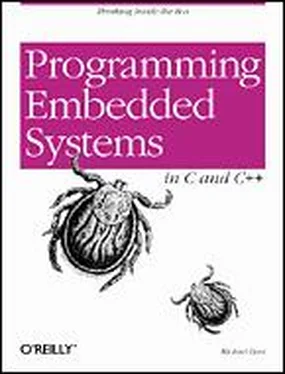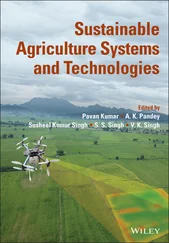8.2 A Decent Embedded Operating System
What follows is a description of an embedded operating system that I have developed on my own. I call my operating system ADEOS (pronounced the same as the Spanish farewell), which is an acronym for "A Decent Embedded Operating System." I think that name really sums it up nicely. Yes, it is an embedded operating system; but it is neither the best nor the worst in any regard. In all, there are less than 1000 lines of source code. Of these, three quarters are platform-independent and written in C++. The rest are hardware– or processor-specific and, therefore, written in assembly language. In the discussion later, I will present and explain all of the routines that are written in C++ along with the theory you need to understand them. In the interest of clarity, I will not present the source code for the assembly language routines. Instead, I will simply state their purpose and assume that interested readers will download and examine that code on their own.
If you would like to use ADEOS (or a modified version of it) in your embedded system, please feel free to do so. In fact, I would very much like to hear from anyone who uses it. I have made every effort to test the code and improve upon the weaknesses I have uncovered. However, I can make no guarantee that the code presented in this chapter is useful for any purpose other than learning about operating systems. If you decide to use it anyway, please be prepared to spend some amount of your time finding and fixing bugs in the operating system itself.
We have already talked about multitasking and the idea that an operating system makes it possible to execute multiple "programs" at the same time. But what does that mean? How is it possible to execute several tasks concurrently? In actuality, the tasks are not executed at the same time. Rather, they are executed in pseudoparallel. They merely take turns using the processor. This is similar to the way several people might read the same copy of a book. Only one person can actually use the book at a given moment, but they can both read it by taking turns using it.
An operating system is responsible for deciding which task gets to use the processor at a particular moment. In addition, it maintains information about the state of each task. This information is called the task's context, and it serves a purpose similar to a bookmark. In the multiple book reader scenario, each reader is presumed to have her own bookmark. The bookmark's owner must be able to recognize it (e.g., it has her name written on it), and it must indicate where she stopped reading when last she gave up control of the book. This is the reader's context.
A task's context records the state of the processor just prior to another task's taking control of it. This usually consists of a pointer to the next instruction to be executed (the instruction pointer), the address of the current top of the stack (the stack pointer), and the contents of the processor's flag and general-purpose registers. On 16-bit 80x86 processors, these are the registers CS and IP, SS and SP, Flags, and DS, ES, SI, DI, AX, BX, CX, and DX, respectively.
In order to keep tasks and their contexts organized, the operating system maintains a bit of information about each task. Operating systems written in C often keep this information in a data structure called the task control block. However, ADEOS is written in C++ and one of the advantages of this approach is that the task-specific data is automatically made a part of the task object itself. The definition of a Task , which includes the information that the operating system needs, is as follows:
class Task {
public:
Task(void (*function)(), Priority p, int stackSize);
TaskId id;
Context context;
TaskState state;
Priority priority;
int * pStack;
Task * pNext;
void (*entryPoint)();
private:
static TaskId nextId;
};
Many of the data members of this class will make sense only after we discuss the operating system in greater detail. However, the first two fields — id and context —should already sound familiar. The id contains a unique integer (between and 255) that identifies the task. In other words, it is the name on the bookmark. The context is the processor-specific data structure that actually contains the state of the processor the last time this task gave up control of the processor.
Remember how i said that only one task could actually be using the processor at a given time? That task is said to be the "running" task, and no other task can be in that same state at the same time. Tasks that are ready to run — but are not currently using the processor — are in the "ready" state, and tasks that are waiting for some event external to themselves to occur before going on are in the "waiting" state. Figure 8-1 shows the relationships between these three states.
Figure 8-1. Possible states of a task
A transition between the ready and running states occurs whenever the operating system selects a new task to run. The task that was previously running becomes ready, and the new task (selected from the pool of tasks in the ready state) is promoted to running. Once it is running, a task will leave that state only if it is forced to do so by the operating system or if it needs to wait for some event external to itself to occur before continuing. In the latter case, the task is said to block, or wait, until that event occurs. And when that happens, the task enters the waiting state and the operating system selects one of the ready tasks to be run. So, although there may be any number of tasks in each of the ready and waiting states, there will never be more (or less) than one task in the running state at any time.
Here's how a task's state is actually defined in ADEOS:
enum TaskState { Ready, Running, Waiting };
It is important to note that only the scheduler — the part of the operating system that decides which task to run — can promote a task to the running state. Newly created tasks and tasks that are finished waiting for their external event are placed into the ready state first. The scheduler will then include these new ready tasks in its future decision-making.
As an application developer working with ADEOS (or any other operating system), you will need to know how to create and use tasks. Like any other abstract data type, the Task class has its own set of routines to do just that. However, the task interface in ADEOS is simpler than most because you can do nothing but create new Task objects. Once created, an ADEOS task will continue to exist in the system until the associated function returns. Of course, that might not happen at all, but if it does, the task will be deleted automatically by the operating system.
The Task constructor is shown below. The caller assigns a function, a priority, and an optional stack size to the new task by way of the constructor's parameters. The first parameter, function , is a pointer to the C/C++ or assembly language function that is to be executed within the context of the new task. The only requirements for this function are that it take no arguments and return nothing. The second parameter, p , is a unique number from 1 to 255 that represents the new task's priority relative to other tasks in the system. These numbers are used by the scheduler when it is selecting the next task to be run (higher numbers represent higher priorities).
Читать дальше












